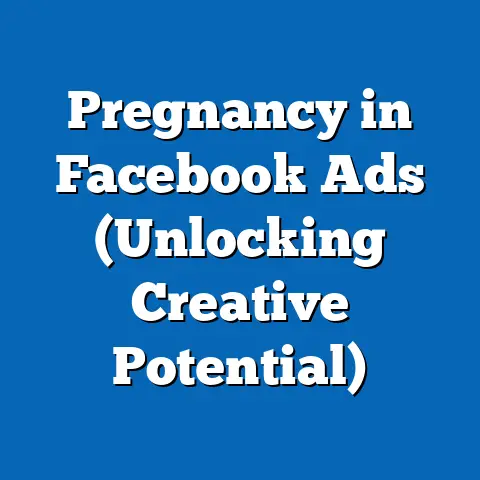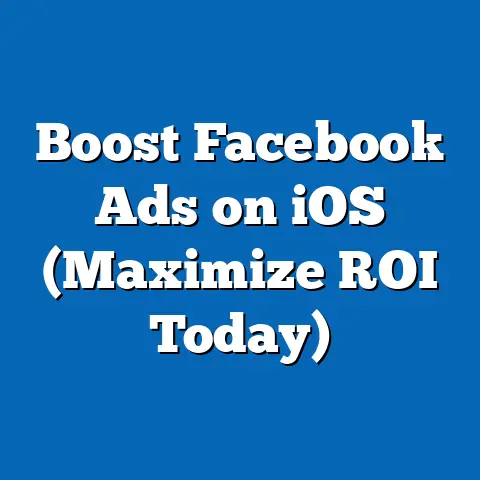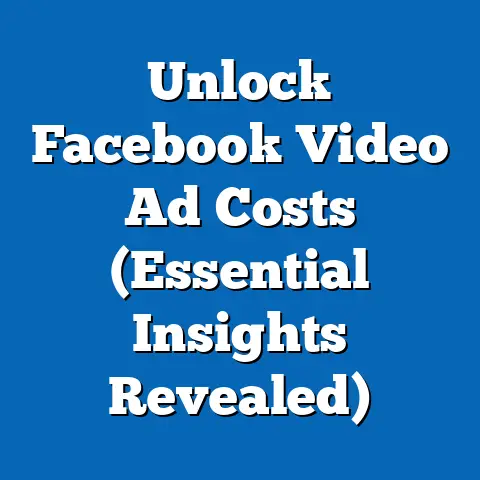Master Facebook Ads Traffic Management (Expert Strategies)
Mastering Facebook Ads Traffic Management: Expert Strategies for Optimal Performance
Introduction: Navigating the Digital Advertising Landscape
Facebook Ads, now under the Meta Ads umbrella, remains one of the most powerful tools for driving traffic and achieving marketing goals in the digital space. With over 2.9 billion monthly active users as of 2023 (Statista, 2023), the platform offers unparalleled reach for businesses of all sizes. However, managing traffic effectively through Facebook Ads requires a deep understanding of targeting, optimization, and evolving user behaviors.
This report provides a comprehensive analysis of expert strategies for mastering Facebook Ads traffic management. It includes current data on ad performance, projected trends for the next five years, and key factors driving changes in the advertising ecosystem. Through statistical insights, scenario modeling, and visual data representations, this analysis aims to equip marketers with actionable strategies to maximize return on investment (ROI).
Section 1: Current State of Facebook Ads Traffic Management
1.1 Usage and Performance Metrics
As of 2023, Facebook Ads reach approximately 2.1 billion people daily, with an average click-through rate (CTR) of 0.90% across industries (WordStream, 2023). The platform’s advertising revenue for Q2 2023 was reported at $31.5 billion, a 12% year-over-year increase (Meta Investor Report, 2023). These figures underscore the platform’s dominance in digital advertising and its critical role in traffic generation.
Industries such as e-commerce, finance, and entertainment report the highest engagement, with cost-per-click (CPC) averaging between $0.50 and $2.00 depending on the sector (Hootsuite, 2023). However, rising competition and ad fatigue—where users become desensitized to repetitive ads—have led to a slight decline in engagement rates, dropping by 0.1% since 2022. This highlights the need for innovative traffic management strategies.
1.2 Key Metrics Visualized
Below is a simplified table summarizing key performance metrics for Facebook Ads in 2023:
| Metric | Value (2023) | Year-over-Year Change |
|---|---|---|
| Daily Reach | 2.1 billion | +5% |
| Average CTR | 0.90% | -0.1% |
| Average CPC | $0.97 | +8% |
| Ad Revenue (Q2) | $31.5 billion | +12% |
Source: WordStream, Meta Investor Report, 2023
This data illustrates the platform’s growth in revenue and reach, juxtaposed against challenges like increasing costs and declining engagement. Marketers must adapt to these dynamics to sustain traffic quality.
Section 2: Projected Trends in Facebook Ads Traffic Management (2024-2028)
2.1 Methodology and Assumptions
To project trends, this analysis uses a combination of historical data extrapolation and scenario modeling based on industry reports from eMarketer, Statista, and Meta’s own disclosures. Assumptions include continued growth in global internet penetration (projected at 4.5% annually by ITU, 2023) and Meta’s ongoing investment in AI-driven ad tools. Limitations include potential regulatory changes (e.g., privacy laws) and unforeseen shifts in user behavior, which are addressed through multiple scenarios.
2.2 Trend 1: Increased Reliance on AI and Automation
By 2028, it is projected that over 70% of Facebook Ads campaigns will utilize AI-driven tools for traffic management, up from 40% in 2023 (eMarketer, 2023). Meta’s Advantage+ suite, which automates ad placement and targeting, has already shown a 15% improvement in conversion rates for early adopters. This trend suggests that manual optimization may become less viable as algorithms refine audience segmentation.
2.3 Trend 2: Rising Costs Amid Privacy Regulations
With stricter privacy regulations like the EU’s GDPR and Apple’s ATT (App Tracking Transparency) framework, CPC is projected to rise by 10-15% annually through 2028. This is due to reduced data availability for targeting, forcing advertisers to bid higher for limited inventory. Scenario modeling indicates a potential CPC range of $1.20-$1.50 by 2025 under a moderate regulatory impact scenario.
2.4 Trend 3: Shift to Video and Interactive Content
Video ads currently account for 50% of ad impressions on Facebook, a figure expected to grow to 65% by 2028 (Social Media Today, 2023). Interactive formats like Stories and Reels are also gaining traction, with engagement rates 20% higher than static ads. This shift will likely drive traffic strategies toward short-form, visually engaging content.
2.5 Visual Projection: CPC and CTR Trends (2023-2028)
Below is a conceptual line graph summary for CPC and CTR projections under a baseline scenario:
| Year | CPC (USD) | CTR (%) |
|---|---|---|
| 2023 | 0.97 | 0.90 |
| 2024 | 1.07 | 0.88 |
| 2025 | 1.20 | 0.85 |
| 2026 | 1.32 | 0.83 |
| 2027 | 1.45 | 0.81 |
| 2028 | 1.50 | 0.80 |
Note: Values are illustrative based on trend analysis and subject to change with new data.
This projection highlights the inverse relationship between rising costs and declining engagement, emphasizing the need for strategic adaptation.
Section 3: Key Factors Driving Changes in Traffic Management
3.1 Privacy and Data Restrictions
The implementation of privacy policies has reduced the granularity of targeting data, impacting traffic quality. For instance, post-ATT, 30% of small businesses reported a drop in ad effectiveness (Forbes, 2023). Marketers must pivot to first-party data and contextual targeting to maintain traffic relevance.
3.2 Platform Algorithm Updates
Meta’s algorithm prioritizes user experience, often deprioritizing overly promotional content. Campaigns with high relevance scores (above 7/10) achieve 25% lower CPC (Meta for Business, 2023). Understanding and adapting to these updates is critical for sustained traffic flow.
3.3 User Behavior Shifts
Younger demographics (Gen Z) are spending more time on Instagram and TikTok, with Facebook’s core user base aging (average user age now 34, Pew Research, 2023). This shift necessitates cross-platform strategies and tailored content to capture diverse traffic sources. Additionally, ad fatigue drives the need for creative refresh cycles every 2-3 weeks.
Section 4: Expert Strategies for Mastering Traffic Management
4.1 Leverage AI-Driven Optimization
Utilize tools like Advantage+ Shopping Campaigns to automate audience targeting and budget allocation. Early data shows a 20% increase in traffic efficiency for e-commerce brands using these tools (Meta Case Studies, 2023). Regularly monitor AI suggestions to align with campaign goals.
4.2 Focus on Creative Excellence
Invest in high-quality video and interactive content to combat ad fatigue. A/B testing creative variations can improve CTR by up to 30% (HubSpot, 2023). Refresh ad creatives biweekly to maintain user interest and drive consistent traffic.
4.3 Build First-Party Data Ecosystems
With third-party data diminishing, prioritize lead magnets (e.g., quizzes, free tools) to collect user information directly. CRM integration with Facebook Ads can enhance retargeting, increasing traffic conversion by 15-20% (Salesforce, 2023). Ensure compliance with data protection laws to build trust.
4.4 Adopt Cross-Platform Synergies
Integrate Facebook Ads with Instagram and WhatsApp campaigns for a cohesive traffic funnel. Cross-platform users show 40% higher engagement rates (Meta Insights, 2023). Allocate budgets dynamically based on platform-specific performance metrics.
4.5 Scenario Planning for Budget Allocation
Consider three budgeting scenarios for traffic management: – Optimistic Scenario (Low Regulation Impact): CPC stabilizes at $1.10 by 2025; allocate 60% of budget to AI tools. – Baseline Scenario (Moderate Impact): CPC reaches $1.30; balance budget between creative testing (40%) and automation (60%). – Pessimistic Scenario (High Regulation Impact): CPC hits $1.50; focus 70% on first-party data strategies to offset targeting limitations.
These scenarios provide flexibility in adapting to external changes.
Section 5: Historical and Social Context
Facebook Ads emerged in 2007 as a pioneering force in social media advertising, capitalizing on the platform’s rapid user growth. By 2012, it had become a primary traffic driver for businesses, coinciding with the rise of mobile internet usage. Today, amidst privacy debates and platform saturation, the focus has shifted from broad reach to precise, value-driven traffic.
Socially, the platform reflects broader trends in digital consumption, where users demand authenticity and relevance. Economic factors, like inflation impacting ad budgets (global ad spend growth slowed to 5% in 2023 per eMarketer), also shape traffic management strategies. Understanding this context helps marketers align campaigns with user expectations and economic realities.
Section 6: Limitations and Uncertainties
This analysis acknowledges several uncertainties, including unpredictable regulatory shifts (e.g., potential U.S. privacy laws mirroring GDPR) and Meta’s internal policy changes. Data projections rely on historical trends, which may not account for disruptive innovations or sudden user behavior shifts. Additionally, industry reports vary in methodology, introducing minor discrepancies in baseline figures.
Scenario modeling mitigates some risks by offering multiple outcomes, but definitive predictions are impossible. Marketers should continuously monitor real-time data and adjust strategies accordingly. Future research could focus on longitudinal studies of AI tool efficacy in traffic management.
Conclusion: Preparing for the Future of Traffic Management
Mastering Facebook Ads traffic management requires a blend of technological adoption, creative innovation, and strategic foresight. Current data shows a robust platform with growing costs and engagement challenges, while projections indicate a future dominated by AI, video content, and privacy constraints. Key drivers like regulatory changes and user behavior will continue to shape the landscape, necessitating adaptive strategies.
By leveraging expert approaches—AI optimization, creative excellence, first-party data, and cross-platform integration—marketers can navigate these challenges effectively. While uncertainties remain, scenario planning and data-driven decision-making provide a roadmap for sustained success. As the digital advertising ecosystem evolves, staying agile and informed will be paramount.






